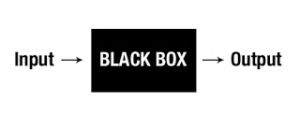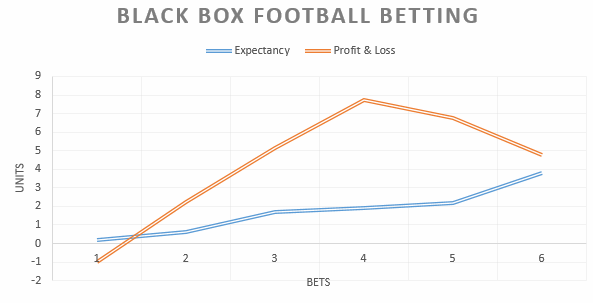The football betting system that I have decided to test is totally different than any other betting system I have tried before. There are two reasons for that:
- I am using statistical data that is presented in a website. I have no idea how this data is calculated.
- The access to the website is restricted to subscribers. Thus, I have to pay a monthly fee, in order to acquire the valuable data.
So, I have to pay some money in order to build my football betting system, since my predictions will be based on these statistics. On top of that, by not knowing how the data is being processed, I am building a betting system that looks like a black box system as a result.
What is a black box football betting system?

A black box system is a betting system that we can’t really know what is happening inside. It’s like those betting systems that promise millions, but go on to sell for just $49! You are not allowed to peek inside the system. You are supposed to only receive football betting tips in your email and be done with it.
Of course the tips should make you money. As long as your betting account is increasing, you are not expected to ask annoying questions. Which is why I never use betting tips to invest my money.
I was never fond of this kind of betting systems. I don’t really care if I could be a millionaire in a month. I want to improve my sports betting skills, I wish to become a profitable gambler by relying on my own powers. On my personal knowledge. On the experience I acquire by creating my own betting system. Much like when I used the tennis ranking system for betting during the Australian Open.
So, why building a football betting system that resembles a black box?
Because it’s only the football data that I have now access to, that is similar to a black box betting system. By the time I can use this data for a specific football game, my football betting system is out in the open. It only needs to find the appropriate value bets.
As long as the payout odds are more generous than the calculated probability of an outcome, the betting system prompts me to place the bet. That is what a value bet is in simple words. Finding odds to bet on that are bigger than the calculated probability of a draw, a home or an away win.
Still, why should I have my betting tips depend on data that someone else comes up with?
Because the developers of the website in question are supposedly using advanced mathematics and statistical analysis to get the job done. One of the numerous methods they are using is called neural networks. I have quite an experience of these networks and I have tried them before in my sports betting ventures. I also blogged about them in my Greek betting blog (use an online translator).
Their well-designed website and the impressive presentation of their work convinced me to try them out as well.
How am I going to test if the football data is accurate?
One creates a football betting system to make money in the long run. That is what I am about to find out. By writing down all the required data in an Excel spreadsheet, tracking results and P&L I will eventually be able to conclude whether the subscription-based website is actually worth it. If they can actually predict the football games better than the market.

How will that happen? Let me explain that now.
Market efficiency in sports betting
You see, the bookmakers’ odds show the percentage of betting volume that each outcome is expected to attract. Bookmakers don’t predict the real probability of each outcome of the football games. They predict how many people will bet on home win, on away win or on the draw. If the home win is available for betting at 2.00, half of the money wagered on the specific game is expected to be placed on the home win.
But odds rarely stay the same. They tend to change as time goes by and as we are heading towards kick-off time. That is because more and more people are betting of the game, creating an imbalance caused by the fact that people have different opinions and ultimately, predictions. An imbalance that bookmakers need to smooth out by altering their odds. By doing that, people will be finding more attractive a bet on a different outcome. Eventually the market will find new balance, till fresh news, rumors or announcements are made public.
In the end, after analyzing decades of sports betting data, the conclusion of betting experts is this:
People are betting in such a way, that the final odds reflect the true probability of the game’s outcome. This is called market efficiency.
So, let’s say a bookmaker offers the bet on home win at 2.20. After a day of betting, the home win’s odds are down to 2.00, just a couple of minutes before kickoff. Thus the true probability of the home team winning the game is 50%, since market is efficient. Those who were quick enough to bet at odds higher than 2.00, have been value betting! By betting at 2.20 while the real probability is 50%, their bet’s value is 10%. In theory, that means they win 10c in the long run for every dollar they bet.
Ok, now that we have explained market efficiency and why people tend to predict football games accurately more often than not, let’s go back to the football betting system.
The results of the football betting system will prove the data’s efficiency
According to the data I am paying for, there were value bets available on yesterday’s Champions League matches. As there are on today’s Europa League’s ones. This data allows to calculate the theoretical value of each bet, depending on the odds I am betting on. After the conclusion of yesterday’s games, the expectancy of the value bets results to a theoretical 60% ROI – that is Return-On-Investment! That stands for 60c winrate for each wagered dollar! Although impressive, I am betting it is unrealistic. I would be delighted if the real performance was even a quarter of that!
Even more surprisingly, the system did really well yesterday, winning just a tad more than that.

I am using a flat betting system when I am testing a betting system. That will allow me to analyze the system’s performance better in the future. At this point one could claim that the data is reliable as the actual P&L is about the same as the theoretical expectancy of the bets.
Yet, the sample is miniscule. I will need to collect data for at least 200 or 300 games. Safe conclusions can be made after 1,000 or more bets. Until then, I will keep track of this football betting system. And before I can be sure of the data’s efficiency, which will also prove that the website’s developers can predict football outcomes better than the market overall, there is no need to reveal the subscription-based website.
But I will come back with my findings and likely confirm the market efficiency once again!


